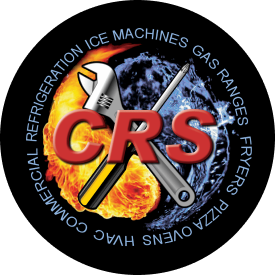Restaurant kitchens are notorious for their hot, sweltering, and uncomfortable working environments. That’s why a well-functioning AC unit makes a world of difference. The HVAC specialists at Commercial Restaurant Services are here to make that happen.
Today, we’ll cover some of the most common HVAC issues found frequently among restaurants in Springfield, Missouri, and surrounding areas.
If you’re in need of emergency repair or on-going HVAC maintenance, contact professional HVAC technicians at 417CRS. Here are some quick red-alert signs that your restaurant needs HVAC repair ASAP:
- Heightened humidity levels
- Too much ventilation and not enough fresh air flowing in (negative air pressure build-up)
- Increased condensation on windows, line tables, and/or grills
- Entry doors are difficult to open (due to building air pressure)
1. Dirty Air Filters
It’s one of the first things we notice when inspecting a restaurant’s HVAC system: clogged, dirty air filters. Air filters should be changed every 4 to 8 weeks, quite frequently.
A restaurant HVAC’s air filters do the heavy lifting. They trap all of the smoke, oils, grease, steam, and other particulates that get ventilated out of the kitchen. As you can imagine, all that crud builds up quickly.
Changing out your old filters with new, clean ones is part of achieving high levels of indoor air quality (IAQ) and, eventually, passing city health inspections when they occur.
2. Clogged Condenser Coil
A clogged and dirty condenser coil will reduce the amount of cool air that enters your restaurant. The kitchen is already a hot, uncomfortable place to be. But when this gets clogged with greases and oils (and eventually it will), your kitchen will quite literally be Hell’s Kitchen.
You won’t be getting cool air, but your makeup air unit will work as normal, adding the hot, outside summer air into your kitchen as your ventilation system, or overhead grill, sucks out the bad air.
“If you have dirty coils and dirty filters, then you’re cutting your capacity down 30-40%, or more,” said Dan Patrick, CEO of Commercial Restaurant Service. “When it gets to a hundred degrees, if you’re already in a bad way, then you’re just really in a bad way.”
3. Low Refrigerant (Freon)
It’s incredibly common to find restaurant owners asking about a malfunctioning AC unit, only to find that there is not enough coolant liquid or refrigerant. Low refrigerant could be due to leaks along the line or in the compressor.
If you are low on refrigerant, your AC could see some major problems. The compressor might break, which will render your AC unit inoperable. On the other hand, with less heat absorption, the indoor coil could get covered in a block of ice.
Our skilled HVAC technicians are trained to detect the reasons behind why your refrigerant is leaking, which can include a high-pressure nitrogen test. We assess your unit to offer the most cost-effective diagnosis method.
4. Thermostat Batteries
Most people forget that the thermostats that regulate the kitchen’s AC levels are battery-run and need to be replaced regularly. To find out the best choice for you, read the manufacturer’s directions.
5. Tripped Circuit Breaker
If airflow becomes blocked, due to any number of factors (clogged air filters and coils included), it will force your AC unit to work extra hard to keep up with the output demands. This will trip the breaker. It can happen if your unit overheats and wears down the capacitor (you’ll know when you hear clicking noises).
6. Water Leakages
Water leaks can result in expensive damages to your AC unit if left unaddressed. Commercial HVAC units have line drains that can get blocked over time. Water leaks could be due to serious issues with an evaporator, collector box, or heat exchanger.
7. Old Age (Worn-Out HVAC Unit)
Sometimes it’s just age. Most HVAC systems will last between 10 to 15 years. Regularly scheduled preventative maintenance services can extend the system’s life quite a bit, and help to keep the parts, from the motors and belts to the bearings, working optimally.
Why is Regular HVAC Maintenance Vital for Restaurants?
“Most kitchens aren’t designed with enough air conditioning capacity.” Dan Patrick, CEO of Commercial Restaurant Service said.
Let’s say there are a million and a half BTUs (British thermal units) of cooking equipment that are going to go underneath this hood. Engineers may state a kitchen needs 10 tons, it probably needs 15 or 18 tons — if you want to keep it 70 degrees in the kitchen (nearly impossible to do in the summer).
Why is it off? It’s because they only calculate the heat load and not the fact that the makeup air unit puts outdoor air into the kitchen, as the vents suction out the AC in the kitchen. This means the HVAC system has to work harder to produce more cool air.
Some kitchens try to make up for the excessive heat load by installing mini-splits on every kitchen wall and room of a restaurant. But they aren’t designed to handle the heavy greases and oils of a kitchen. In two or three years, they clog up and ruin.
It’s important to schedule regular maintenance on your restaurant’s HVAC system to ensure you’re not overpaying on your monthly utility bills, and to avoid serious repair issues down the road.
Contact 417CRS for Commercial Restaurant HVAC Repair in Springfield, MO.
If you’re in need of repair or maintenance services for your kitchen’s HVAC, Commercial Restaurant Service is here to help. Contact us for more information today at (417) 226-2614.
